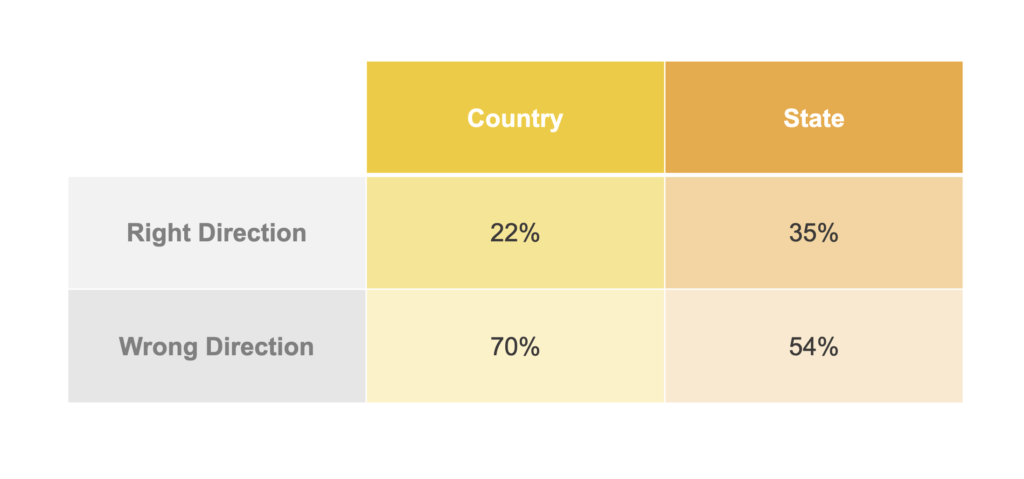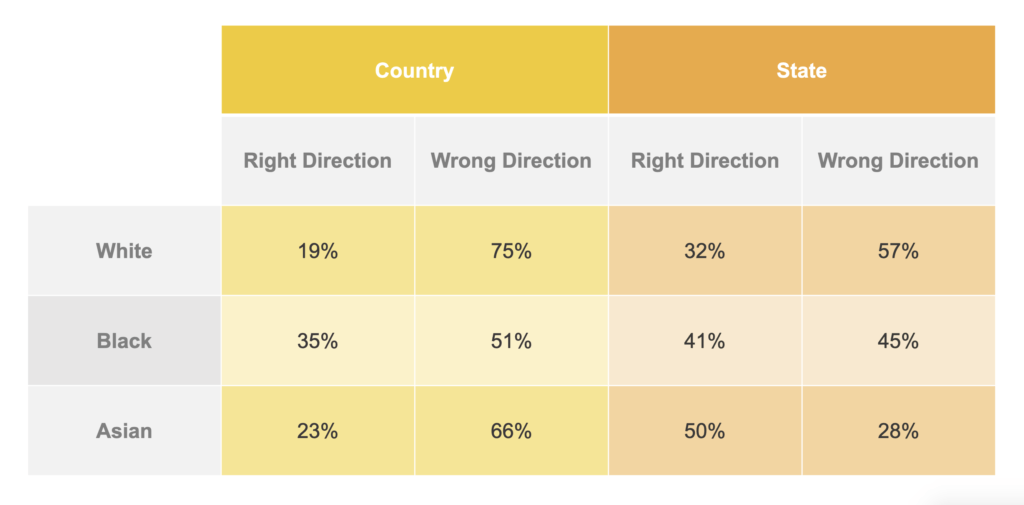By Bruce Blakeman and Dee Allsop
In an America where no one agrees on anything, a majority of registered voters are satisfied with the performance of their state and local governments – a far cry from the 33% satisfied with the federal government and just 16% who trust the federal government.
In our August 2022 survey of 826 registered voters, two out of three (67%) are not satisfied with the federal government. But they are significantly more satisfied with their state (50%) and local governments (56%).
This situation presents state and local governments an opportunity to fill the leadership vacuum left by Washington. This vacuum will be even more evident if the GOP picks up one of the chambers of Congress resulting from the mid-term election, which is possible considering the current political environment.
Non-whites have higher levels of satisfaction with government than do whites with all three levels of government. Asian voters are the most satisfied with all three levels of government: 53% federal, 70% state, and 69% local. A majority of Black voters are also satisfied with all levels of government, and satisfaction grows as government gets closer to Black registered voters: 51% federal, 56% state, and 61% local. Hispanics are also more positive about the federal government than whites with 41% approving. A majority of Hispanics are satisfied with their state (54%) and local (59%) governments.
Only white voters have a majority dissatisfied with both federal (74%) and state (53%) governments, while a majority of white voters are satisfied with their local government services (54%).
Related: Republicans, Democrats, and Independents Equally Concerned About the Country
Both Republicans and Independents are dissatisfied with the federal government. Only 13% of Republicans and 17% of Independents are satisfied. Democrats tend to be satisfied with all three levels of government: 55% federal, 56% state, and 64% local. While surveys have consistently shown voters overwhelmingly believe the country is seriously on the wrong track, voters are more positive about the direction of their state. We found just 22% of voters feel the country is heading in the right direction and 70% say we are on the wrong track; at the same time, 35% of voters feel their state is heading in the right direction. By a margin of 13 percentage points, more voters feel their state is heading in the right direction as compared to the country’s direction. The chart below shows the differences.

Younger women tend to be the most negative with both the direction of the country and their state with 76% saying the country is on the wrong track and 63% for their state.
White voters are more pessimistic than both Black and Asian voters about directions of both the country and their state. Asian voters are some of the most optimistic voters about their state (50% right direction).

While registered voters are more satisfied with government closer to them, conversely, a majority believe the federal government is the most effective level of government in providing positive change on critical issues. Overall, 63% of voters feel the federal government can best handle important issues, while 28% think the state is most effective, and 9% believe local government is the most effective.
Democrats are more likely than Republicans to feel the federal government is the most effective in solving critical issues; however, a majority of Republicans agree with Democrats: 68% of Democrats say the federal government is the most effective while 59% of Republicans also agree.
Related: Top Strategies For Sensitive Issues
Interestingly, a majority of voters who cite fighting crime as a top issue say the federal government would be the most effective in solving this issue (58% federal, 35% state, and 7% local). The same trend is true for registered voters who think immigration control at the Southern border is a major issue (65% federal, 27% state, and 8% local) and gun control registered voters (74% federal, 19% state, and 6% local).
With registered voters so untrusting and disillusioned by the acrimony in Washington, there is an opening for states and localities to take action on important issues with voters. Voters will welcome state and local initiatives to improve the economy, fight crime, create jobs, lower taxes, protect parents’ rights, protect the environment, and enhance education and training. Key stakeholders like trade associations, corporations, think tanks, parents rights groups and issue advocacy groups have an opportunity to address issues at the state and local levels of government. They should be ready to propose state and local policies and have strategies to move their policy agenda forward while Washington is stymied.
Join us for our Connections Roundtable on September 29, where we’ll be talking with industry experts about the upcoming midterm elections, and how to move policy in a divided government. Register here.

